Both of these items are pretty much a “no brainer” installation. I put them here for the new folks who ask about these items. A couple of clear photos sure can help you get the idea across.
Rear Tow Hook
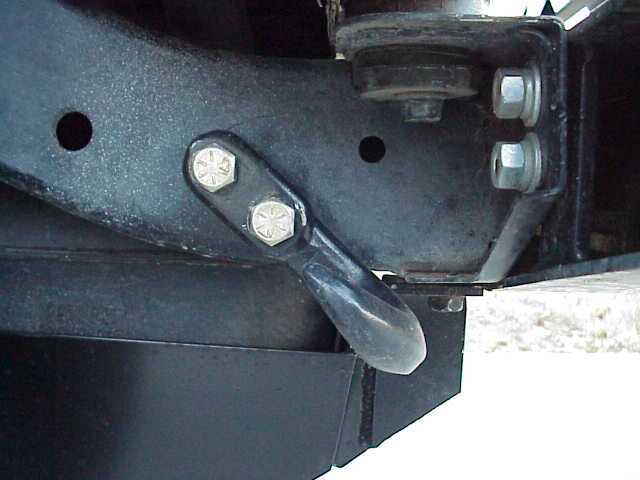 Rear Tow Hook
Rear Tow Hook
This is the new rear tow hook mounted on the driver side frame rail, just in front of the bumper. One of the holes was already there (I forget which one now) and the other was drilled to accomodate the 2nd bolt. The hooks are your regular 10,000 lb. variety that you can get for about $10 a piece at your local 4×4 shop. I picked up the Grade 8 bolts at the local autoparts store. I think they were 1/2″ bolts. You can check for the proper bolt size once you pick up your hooks. I mounted them at about a 45° angle. The lower end of the hook extends just below the bottom of my rock bumper. They do NOT drag as the gas tank sits much lower than the hooks do. They will, however, pull a Suzuki Samarai out of a dry wash and up a hill!
Gas Tank Skid Plate
The Tomken gas tank skid plate might very well be the best one on the market. I have yet to read a newsgroup posting from an owner that said something like “Gee, I sure wish I had gotten the other brand”. I have seen postings from non-Tomken owners stating they did not like the brand they got. Shortly after I installed it, I did a two day trip with a CJ-7. I had a chance to test it several times while running Red Creek. A wet tire slipped off of a rock and I set the TJ’s tank down on another rock. It hit hard enough that I winced and Joe (the other driver) heard it in his Jeep, about 20 yards behind me. How did it hold up? It did just what it was suppose to do. I did notice that the mounting bracket (it hit about an 1″ from where the bracket attaches to the plate) is flexed just a bit….maybe a 1/16″ or so. I only noticed it while I was down taking photos, and then only after comparing the right and left rear brackets. Like I said, it performed its job very well.
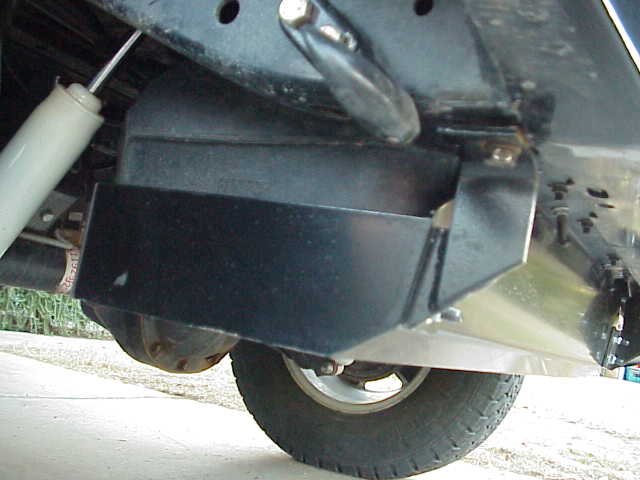 Left rear corner of skid plate
Left rear corner of skid plate
I had to do a tiny bit of grinding on the rear brackets. I don’t fault Tomken for this problem. My aftermarket rock bumper has a couple of thick welds right where the rear skid plate brackets bolt up into the frame rails. (They share the same BIG mounting bolt that is used by the bumper.) If the factory bumper had been there, it would not have required any alteration.
In the above photo, you can see how well the skid covers the left side of the tank. The factory skid plate (ha ha) leaves this side completely unprotected, making it all to easy for a sharp rock to do it’s damage.
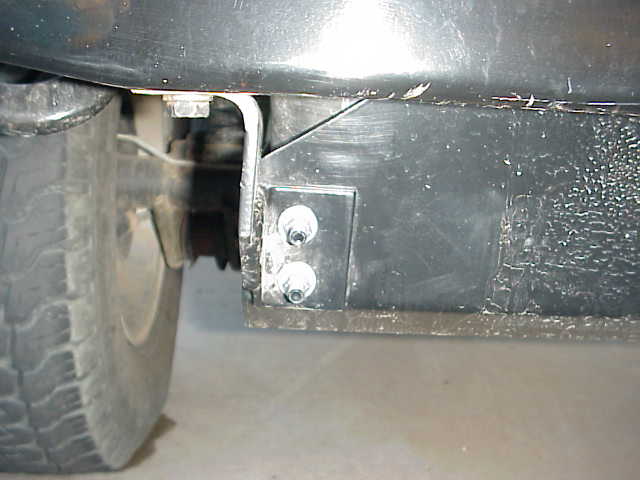 Left rear mounting bracket
Left rear mounting bracket
The above photo gives you a pretty good shot of one of the rear mounting brackets. You can see that it is quite thick. It mounts directly to the bottom of the frame rail and is attached to the skid plate with two good size studs.
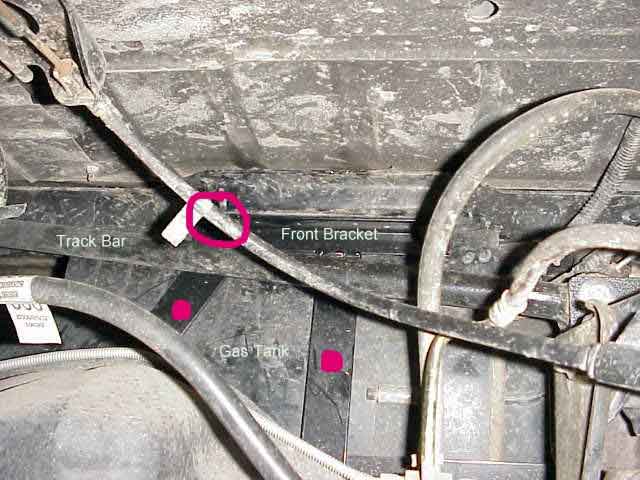 Front mounting bracket
Front mounting bracket
I included this view of the front mounting bracket. It piggy backs onto an existing bracket. The red dots are on the bracket members that go down to the front edge of the skid plate. The end of the bracket which is circled in red was hitting my track bar. This TJ has a TeraFlex lift on it, and this might very well have been the reason that the two were getting into each other’s air space. It would rub at moderate to heavy compression. A few minutes with the die grinder and I was able to round of the end of the bracket that was hitting the track bar.
Aluminum Gas Tank Skid
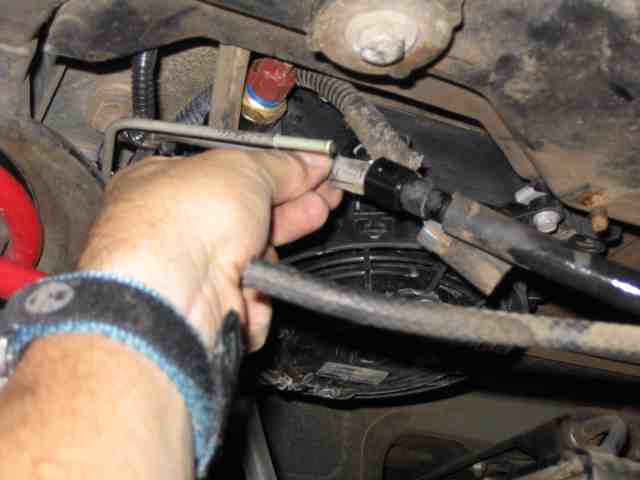 The gas line has a fitting that can be separated quite easily. Remember that you will have some residual pressure (and gas) in the line so you might want to drape a rag over the fitting as you pull it apart. Mine did not “spray” but it did dribble an ounce or two of gas. The fitting is separated by pushing the two plastic ears inward so that the ears disengage the metal collar they lock in to. With the ears pressed inward, gently pull the fitting apart.
The gas line has a fitting that can be separated quite easily. Remember that you will have some residual pressure (and gas) in the line so you might want to drape a rag over the fitting as you pull it apart. Mine did not “spray” but it did dribble an ounce or two of gas. The fitting is separated by pushing the two plastic ears inward so that the ears disengage the metal collar they lock in to. With the ears pressed inward, gently pull the fitting apart.
Note: ’97~’04 vehicles: The electrical connector has a red locking tab on it. Push the red tab to unlock the connector and then squeeze the vehicle side of the connector to release it. Gently pull the connector apart while squeezing it. It is rather difficult to describe, but like most electrical connectors in the TJ, it will come apart when you get the correct piece pushed into position.
Note: ’05~’06 vehicles: (I got this from one of the TJ forums….I’ve not verified it since I don’t have that TJ.) Pull the red tab all the way out of the plug and set it aside. It comes right out. Press down on top of plug (it does not seem to move or move much at all, but it does move) and wiggle the connector side to side while trying to unplug it. It is a bear to do and have to press down on thumb tab the entire time. Here is a nice tip. The electrical connection wire is the longest connection under there. With my Budget Boost 2 1/2 lift , 31″ tires , and 1.25″ body lift the fuel tank itself can sit on the ground with no jack under it with out the wires being pulled tight.
At this point, you have the fuel/vapor lines and electrical connector disconnected. Lower the tank further, making sure the filler hose doesn’t get hung up on anything as it slides down the inside of the rear corner. Some vehicles will have a ground stap attached to the filler hose. Mine had one and it was clipped to a lip on the tub at the other end. Just push the clip off of the tub to disconnect the grounding strap.
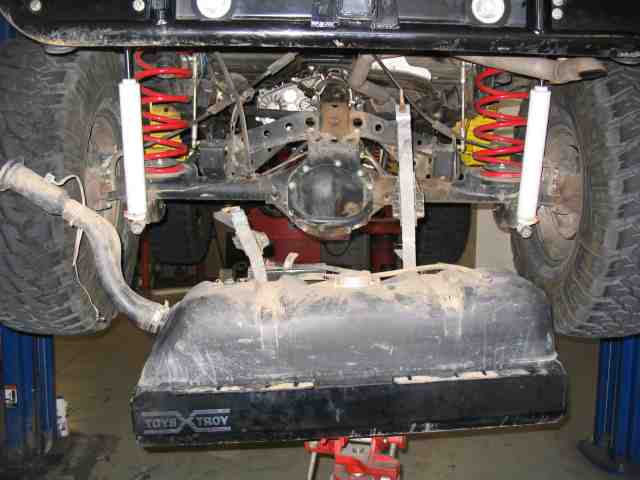 A picture of the tank completely removed from the vehicle. The filler hose is on the left side. Two metal straps hold the gas tank in the skid. Carefully bend them toward the front edge of the tank. You may have to carefully unplug one of the vent lines to get the strap past it. The straps will be used on your new skid so remove them from the factory shield.
A picture of the tank completely removed from the vehicle. The filler hose is on the left side. Two metal straps hold the gas tank in the skid. Carefully bend them toward the front edge of the tank. You may have to carefully unplug one of the vent lines to get the strap past it. The straps will be used on your new skid so remove them from the factory shield.
 Lift the plastic tank out of the factory skid. (You can see the wet spot on the old skid where the gas line dribbled a bit of gas when I disconnected it.)Installation is pretty much the opposite of the removal. Place the plastic tank into your new skid and put the metal straps back into position. Carefully raise the tank up until you can make the electrical and gas line connections. Watch the placement of the vent lines so that they do not get pinched when the tank is completely in position. Doing so will most likely cause a Check Engine light on your dash. Replace the mounting hardware and secure the filler hose in place using the previously removed Phillips screws. Again, make sure none of your hoses are pinched between the top of the tank and the cross member above the tank.That is about it. Check your hose connections one more time and then start up your Jeep to make sure all is working correctly. If your engine won’t start, check the electrical connector again. Chances are you do not have it plugged together correctly and so the fuel pump is not supply gas to the injectors.
Lift the plastic tank out of the factory skid. (You can see the wet spot on the old skid where the gas line dribbled a bit of gas when I disconnected it.)Installation is pretty much the opposite of the removal. Place the plastic tank into your new skid and put the metal straps back into position. Carefully raise the tank up until you can make the electrical and gas line connections. Watch the placement of the vent lines so that they do not get pinched when the tank is completely in position. Doing so will most likely cause a Check Engine light on your dash. Replace the mounting hardware and secure the filler hose in place using the previously removed Phillips screws. Again, make sure none of your hoses are pinched between the top of the tank and the cross member above the tank.That is about it. Check your hose connections one more time and then start up your Jeep to make sure all is working correctly. If your engine won’t start, check the electrical connector again. Chances are you do not have it plugged together correctly and so the fuel pump is not supply gas to the injectors.
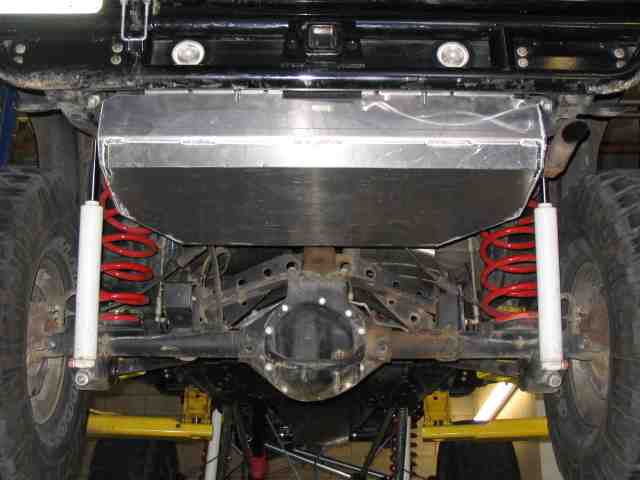 Here is a picture of my new skid, bolted in place and ready to try out a few rocks. It was installed just a few days before my 2006 Moab run. When I get done with the run, I’ll try to remember to post some comments on how the skid worked.
Here is a picture of my new skid, bolted in place and ready to try out a few rocks. It was installed just a few days before my 2006 Moab run. When I get done with the run, I’ll try to remember to post some comments on how the skid worked.
Update 5/21/2006:
Of course, no one knows how good a skid works until it is put to the test…..in this case, where the rocks meet the aluminum.I had a chance to evaluate its performance yesterday, on a local trail call Die Hard. We ran it with 6 vehicles….two rock buggies and 4 TJs. I was the smallest TJ with 35″ tires…..everyone else had 37 or 38″. The buggies were on 40″. Needless to say, it was a difficult trail (for me at least).
 Here is a picture of the skid, about 50 yards from the end of the trail. It did everything I asked of it and more. The winch line is going back to one of the buggies…..he blew a rear axle on a waterfall climb. Did I mention this was a hard trail? The diff guard and rear bumper….all that freshly ground up white rock residue…..a testimony to there being plenty of rocks to present a good challenge.
Here is a picture of the skid, about 50 yards from the end of the trail. It did everything I asked of it and more. The winch line is going back to one of the buggies…..he blew a rear axle on a waterfall climb. Did I mention this was a hard trail? The diff guard and rear bumper….all that freshly ground up white rock residue…..a testimony to there being plenty of rocks to present a good challenge.
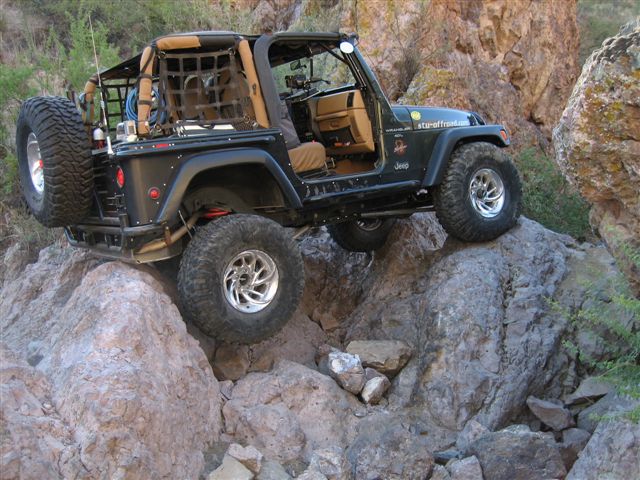 Another picture of the aluminum gas tank skid doing it’s job. Notice the air below the passenger rear tire? The skid is sitting on the rock which is holding up the rear of the vehicle. (yes, I made it through there OK) As I said, the aluminum skid did everything I asked of it and more.
Another picture of the aluminum gas tank skid doing it’s job. Notice the air below the passenger rear tire? The skid is sitting on the rock which is holding up the rear of the vehicle. (yes, I made it through there OK) As I said, the aluminum skid did everything I asked of it and more.

